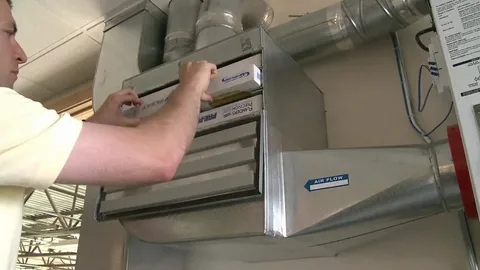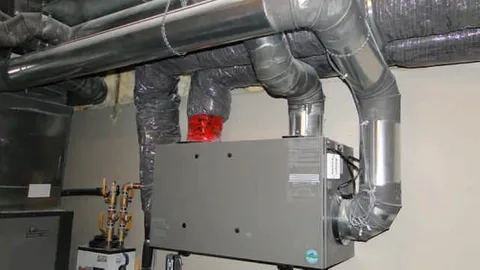Heating your home efficiently and affordably is a challenge for many homeowners. But with the right technology, you can get the most out of your heating system while keeping your costs low. Hrv Heating technology is one of the most efficient and cost-effective solutions available. In this blog post, we’ll explain Hrv-Heating technology and how it can help you optimize your comfort and energy savings.
What is Hrv Heat Transfer System?
HRV, or Heat Recovery Ventilation, is a heating system that utilizes a heat exchanger to transfer heat from one space to another. It works by extracting warm air inside a building and exchanging it with fresh, cold air from outside. The system then filters and heats the incoming air, providing a continuous flow of warm and clean air throughout the building.
Hrv-Heating is particularly effective in areas with harsh winters or cold temperatures, as it can provide constant heating without wasting energy. The technology is also becoming increasingly popular in newer homes and buildings due to its energy efficiency and ability to improve indoor air quality.
If you are considering investing in an Hrv Heat Transfer System, it is essential to research and select the system best suited to your needs and budget. With the right system and maintenance, Hrv-Heating can optimize comfort and energy savings in your home or office.
 How does the Heating System work?
How does the Heating System work?
HRV-heating uses a heat recovery ventilator (HRV) system to transfer heat from one area to another. Essentially, this system transfers the warm air inside your home to the fresh, cooler air outside. This way, you get fresh air without compromising your indoor temperature.
HRV systems are composed of two parallel ducts: one that draws air into the house and another that draws air out of it. The air is drawn in and out and separated by a heat exchanger, transferring the heat from the outgoing air to the incoming air. This heat exchange allows for optimal temperature control since it balances warm indoor air and cool outdoor air.
The heat recovery process can also help reduce the overall heating requirements of your home. By using HRV-heating technology, you can use less energy to heat your home, reducing your carbon footprint and monthly energy bills. That makes it an eco-friendly and cost-effective solution for any household.
However, HRV-heating is only one of the many heating systems available. Depending on the size of your home, budget, and preferences, other heating systems may suit you better. That’s why it’s important to know what you’re looking for when considering HRV-heating or any other heating system.
Benefits of Using Hrv Heat Exchanger
Heating your home using HRV technology has numerous benefits. The most significant benefit is the energy savings. The system uses the energy in the stale air to warm up the fresh air coming into the house. It means you don’t have to rely solely on your heating system to maintain the desired temperature, saving you money on energy bills.
Another benefit of Hrv-Heating technology is that it enhances indoor air quality. The system filters and removes pollutants from the incoming air, leaving you with fresh, clean air to breathe. It also balances your home’s humidity levels, ensuring a comfortable living environment.
Using Hrv Heat Exchanger helps to reduce condensation and dampness, which can lead to mould growth. It is because the system eliminates excess moisture from the air before it enters the house. Hrv-Heating technology is also noise-free, meaning you can enjoy a peaceful, quiet environment.
Hrv-Heating systems are also easy to install, operate, and maintain. They don’t require ductwork, so they are a more flexible option for those with older homes or homes without an existing HVAC system. Furthermore, the system’s components are durable, requiring minimal upkeep and can last for years.
In summary, using heat exchangers is a cost-effective, efficient, and practical solution to your heating needs. With improved indoor air quality, balanced humidity levels, and reduced energy bills, it’s an investment worth considering for any homeowner.
Types of Heating Systems
When it comes to heating your home, there are several options available. Understanding the different types of heating systems can help you make an informed decision about which one is best suited for your needs.
- Furnaces: Furnaces are one of the most common types of heating systems. They burn fuel, such as gas, oil, or propane, to heat the air, which is then distributed throughout the home via ductwork.
- Boilers: Boilers use water or steam to distribute heat throughout the home. They are typically fueled by gas, oil, or electricity.
- Heat Pumps: Heat pumps are an electric heating system that uses refrigerant to transfer heat from the outdoor air or ground into your home. They can also work in reverse during summer to provide air conditioning.
- Radiant Heating: Radiant heating systems use electric panels, hot water tubing, or cables installed beneath the floor or in walls and ceilings to provide heat.
- HRV-Heating: Hrv-Heating systems utilize heat recovery ventilators to transfer heat from the outgoing stale air to the incoming fresh air. These systems work by extracting heat from the exhaust air and using it to preheat the incoming fresh air, resulting in significant energy savings.
Choosing the right type of heating system for your home will depend on various factors, including your home’s size, heating needs, and budget. Consulting with a qualified HVAC professional can help you make the best decision for your home.
Factors to Consider when Choosing Hrv Heat Recovery Ventilator
If you’re in the market for a new Hrv Heat Recovery Ventilator, choosing the right one for your specific needs and circumstances is essential. Here are some factors to consider when making your decision:
- Size and Capacity: The size and capacity of the HRV will depend on the size of your home and how many rooms you need to heat. Make sure you choose an HRV that is appropriately sized for your space to ensure maximum efficiency and effectiveness.
- Energy Efficiency: Look for HRV models with high-efficiency ratings and low energy consumption. It will help reduce your energy bills and minimize your environmental impact.
- Noise Level: Some HRV models can be quite noisy, distracting, and annoying. Look for models designed to operate quietly, especially if you use the HRV in a bedroom or other quiet space.
- Cost: HRV systems can vary significantly in cost, so choose one that fits your budget. However, remember that a higher-quality, more efficient HRV may cost more upfront but will save you money in the long run through reduced energy bills.
- Brand Reputation and Customer Reviews: Research the brand and read customer reviews to understand the HRV’s reliability, durability, and overall performance.
By considering these factors when choosing an HRV, you can ensure that you select a model that meets your heating needs and provides efficient, reliable performance.
Maintenance and Upkeep of Best Energy Recovery Ventilator
Proper maintenance of your HRV heat-recovery ventilator is crucial in ensuring its optimal performance and longevity. The good news is that keeping your unit in good working condition is relatively easy, and you don’t need any specialized knowledge or tools to get it done.
Here are some simple tips on how to maintain and care for your Best Energy Recovery Ventilator:
- Clean or replace filters regularly: Your HRV unit comes with filters that must be cleaned or replaced regularly to maintain optimal airflow and air quality. Follow the manufacturer’s recommendations on how often to clean or replace your filters.
- Keep the exterior and interior clean: Dirt and debris can accumulate on your HRV unit, both inside and outside, reducing its efficiency. Use a damp cloth to wipe the exterior of your unit and clean the interior as per the manufacturer’s instructions.
- Inspect and clean the ductwork: The ductwork that connects your HRV unit to the rest of your HVAC system needs to be inspected and cleaned regularly to prevent dust and debris buildup that can affect airflow and air quality.
- Schedule professional maintenance: Consider having an experienced technician service your HRV unit at least once a year. They can inspect the unit thoroughly, identify potential issues, and perform maintenance and repairs to keep it in good working condition.
- Monitor your energy bills: If you notice a sudden spike in your energy bills or if your HRV unit is not functioning properly, it’s time to have it inspected by a professional technician.
Maximizing Energy Efficiency with the Best Heat Recovery Ventilator
Investing in the Best Heat Recovery Ventilator (HRV) can maximise energy efficiency and reduce your heating costs. Here are some tips on how to get the most out of your Hrv-Heating system.
- Optimize your settings: Most HRV systems come with programmable thermostats, which allow you to set different temperatures for different times of the day. Use this feature to your advantage by programming lower temperatures at night or when you’re not at home.
- Keep your HRV well-maintained: Just like any other appliance, an HRV requires regular upkeep to perform efficiently. Replace filters regularly and clean the heat exchanger periodically. Consult the manufacturer’s instructions for specific maintenance requirements.
- Seal your home: An HRV is most effective in a well-insulated home. Check for drafts around doors and windows, and seal them to keep heat from escaping. A tightly sealed home will help to keep the air quality at its best.
- Invest in energy-efficient windows: If you’re due for a window replacement, consider investing in energy-efficient windows. They help keep your home well-insulated and make your Hrv-Heating system work even more efficiently.
- Use your HRV strategically: An HRV is designed to circulate fresh air while recovering heat from the outgoing air. During winter, briefly open windows to allow fresh air exchange and minimize condensation. When cooking, running a bath or showering, ensure to turn the HRV on.
By following these simple tips, you can optimize the efficiency of your Hrv-Heating system and enjoy greater energy savings in the long run. An HRV can be a wise investment in comfort, convenience, and energy savings, with the benefits far outweighing the initial costs.
Conclusion
Heating technology is a great way to efficiently heat your home while saving energy and reducing your carbon footprint. Utilizing a heat exchanger can provide consistent warmth while minimizing heat loss and reducing the need for additional heating sources.
| Other Good Articles to Read |
| Blogs Rain |
| Cme Blog Spot |
| Garcias Blogs |
| Yyc Blogs |
| Guiade Blogs |
| Blogs-Hunt |
| Impact-Blog |
| Smarty Blogs |
| Ed Blog |
| Mo Blogs |
| Blogs Em |
| Blogs T |



